Dynasties 12-14
c. 1991 - 1640 BC (c. 470 years)
By Ottar Vendel
1991 - 1783 BC (208 years)
divine kingship, but all in the minds of the pharaohs themselves.
Its glory lies in the fact that the rulers were able leaders
developing agricultural methods and exploiting
the Faiyum. They all tried to imitate the
great pharaohs from the passed.
Egypt was prosperous and
the era saw at least
seven more
pyramids.
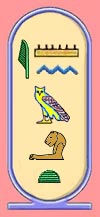 Amenemhet |
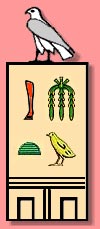 Wehemmesut |
Thus he was not of royal stock, and this had effect on the historical documents he and his offspring produced for the next couple of hun-dreds years to come.
As pharaoh he took the Horus name Wehem- mesut (in the serek right) meaning "Repeated of Births". An inscription at Thebes tells that he probably was the son of the woman Nofret from Elephantine, and the priest Senwosret, a name he gave his son, who was Egypt's first co-regent as pharaoh and was given practice in military matters and other duties.
He restored the broken diplomatic contacts with big trade center Byblos in today's Lebanon, reintroduced conscription to the armed forces and reorganized the admin-istration of the country to a centralized ruled state.
A remarkable event was that he abandoned his home town and capital Thebes in the south and built a new one at the edge of the Fayum in the north to get better control of tha part of the country. It was named "Itj-tawy", which means, "Seizer of the Two lands", meaning the king himself. Its exact location has not yet been dis- covered but it is probably in the area around the modern town of el Lisht.
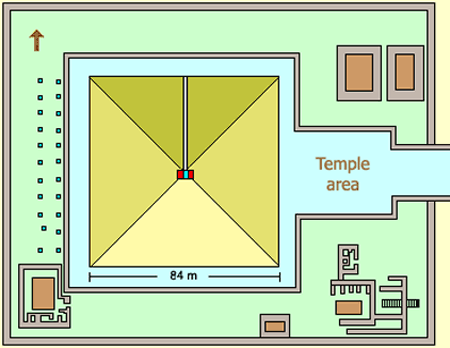 |
The pyramid complex of Amenemhet I at Lisht also has five mastabas (brown), underground galleries and 22 burial shafts (left) for royal women. Pharaoh's grave chamber (red) was placed at the bottom of a vertical shaft (green) in the very center deep under the monument. |
Few monuments of his are located at Thebes and he abandoned his completed tomb there for a pyramid at the new capital. The reason for this is a mystery to Egypto- logists and would later in history have a partial parallel during the New Kngdom.
His pyramid (name: Amenemhet is high and pleasant) imitated the architecture from the ones of the Old Kingdom, but his means were far from those of the great pyramid builders. Thus his monument was a construction with a core of rough cut stone with filling in between of rubble and then cased with smooth limestone. To some extent the material was taken from older ruined monuments in Giza and Sakkara. Only the inner core is left today.
After campaigning the people in the Middle East in his first years, he built the so called "Walls-of-the-Ruler", as series of fortifications along Egypt's north-eastern frontier. But as late as in his 24th year of rule, inscriptions tell of expeditions against the "sand-dwellers" in southern Palestine.
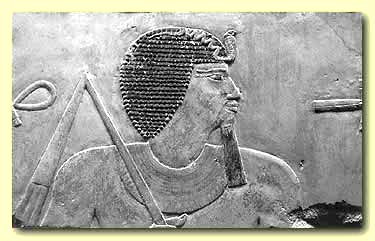 |
Amenemhet I shown on a relief from his mortuary temple. He is wearing a short wig, false beard and carrying a flail. |
In his 29th ruling year he strengthened trading and quarrying in Nubia to get raw materials and metals and drove his army possibly as far south as the second cataract. He founded a fortress at Semna in the same region.
Amenemhet started several building projects. Besides the many fortresses he also built or restored religious monuments at Babastis, el-Khatana, Tanis, Karnak, Koptos, Abydos, Dendera and at the old capital Memphis, where he built a temple to the big local god Ptah.
He appears to have been a wise leader, though hard, eager to protect Egypt's borders from intruders. A literary work from the time of his successor tells that he was brutally murdered in a harem plot. This way to depart from earthly life was unique for Egyptian pharaohs and he must have been an old man by then.
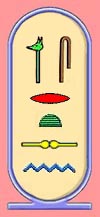 Senwosret |
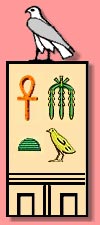 Ankhmesut |
It was called "Instructions of Amenemhet" and is a classic piece in Egyptian literature.
He captured Lower Nubia and built over a dozen fortresses as far south as the second cat-aract like the large stronghold at Buhen whose remains now are forever lost under the water of Lake Nasser.
The economic importance of the region lay in its mineral mines with quarrying of gold, amethyst and gneiss. Expeditions were also sent through the path Wadi Hammamat to the Red Sea during his reign which was a time of stability and development.
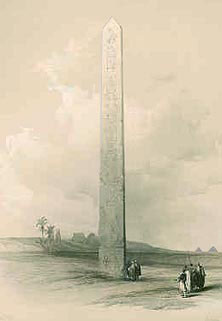 From surviving letters we know that a famine took place during his reign and along with this news we also are got increased insight into the life of the common Egyptians. He expanded the cult of Osiris making him the god of the people. He set up a program to build monuments in every main cult city in Egypt and remnants are stated from over thirty sites from the Mediterranean Sea in the north to Lower Nubia in the south.
From surviving letters we know that a famine took place during his reign and along with this news we also are got increased insight into the life of the common Egyptians. He expanded the cult of Osiris making him the god of the people. He set up a program to build monuments in every main cult city in Egypt and remnants are stated from over thirty sites from the Mediterranean Sea in the north to Lower Nubia in the south.He remodelled the temple of Khentiamentiu and Osiris at Abydos and constructed two new shrines at Karnak and Heliopolis. In the latter he erected two 20 meter (121 tons) red granite obelisks for the jubilee of his 30th year in office and one is still standing as the oldest obelisk in Egypt (see also drawing left).
He built his pyramid at Lisht close to the Fayum basin (name: "Senwosret Looks Down on the Two Lands") and today it's just a ruin. Local limestone was used in the core and it was built as a framework of walls radiating from the corners and filled with stone debris, sand and waste material.
 The valley temple is not exactly located and the long causeway, now hidden under the sand, still awaits a proper investigation.
The valley temple is not exactly located and the long causeway, now hidden under the sand, still awaits a proper investigation.The inner enclosure wall was built of limestone and had panels every five meters decorated with reliefs. A total of 150 were originally pre-sent topped with the king's names. The mortuary temple was almost completely ruined when excavated in 1894. Its court yard had 24 pillars and there was found a granite altar with inscriptions and reliefs. In its rear came to light the feet of a statue that originally had shown the king about 2.7 meters tall.
Eight standing large statues, and a catch with ten more than life-size statues of pharaoh sitting on a square block, have been found here.
The entrance to the pyramid's interior is located below the pavement of a little chapel on the north side where a corridor made of granite goes down to the grave chamber passing a barrier of huge blocks weighing 20 tons a piece.
This construction is today below ground water level and has never been entered by modern archaeologists. In parallel corridor made by robbers, some items were found in the 1880s including parts of wooden boxes, alabaster containers, a gold dagger sheath etc.
The complex of Senwosret I at Itj-tawy (Lisht) was built within two enclosed areas with ten minor pyramids of which nine were tombs of his consorts. The interior was simple and the single burial chamber was entered from the north side by a corridor starting from a little chapel. The mortuary temple was constructed very close, a style from the fifth dynasty. | 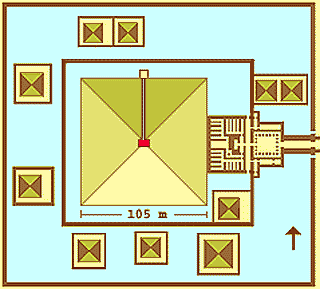 |
All subsidiary pyramids did not receive burials because some lack a grave chamber. These tombs probably all belong to members of the royal family and some cases the owner has been identified. One of these - Nofret I, the king's first queen and sister, had her name written within a cartouche. This was the first time in Egyptian history that another person but the pharaoh had this privilege.
 Amenemhet |
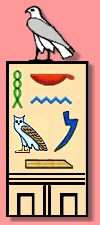 Hekenenmaat |
He chose to build his pyramid at Dahshur in a lone- ly pyramid field from the 4th Dynasty.
His monument was called "The Mighty Pyramid" and was placed east of the Red Pyramid of Snofru. Today it's called "The White Pyramid" and is in a ruined state and the side is estimated to have been about 53 meters.
The broad causeway is probably not investigated at all and the valley temple is yet to be found at the old bank of the Nile just 250 meters from the complex. The mortuary temple is almost com-pletely destroyed and has not been properly examined.
Two tower-like structures like pylons are visible in the temple's east facade (see picture below). The core of the pyramid was built much like that of his father's but here the filling in-between the rough blocks was only sand.
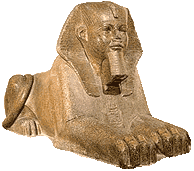 Great phinx of Amenemhet II length: 4,8 m. (The Louvre). |
West of the pyramid were found tombs of the king's children, one son and four daughters. In two tombs of the females were found magnificent jewelry in 1895 by the French archaeologist De Morgan and today this treasure can be seen in the Egyptian Museum in Cairo.
No military campaigns are recorded from Amen- emhet's reign, but he sent an expedition to the Red Sea through the east mountains and then south to the land of Punt.
He was also a pioneer in developing the Faiyum marshlands to something more productive, a task that many of his predecessors would continue to do.
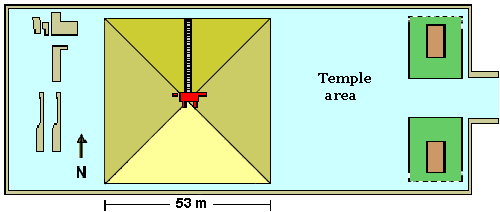 |
The pyramid of Amenemhet II at Dahshur was built within a narrow rectang-ular enclosure wall of third dynasty style. The massive pylons (green) were of fifth dynasty fashion and west of the building are underground tombs for his wifes and children (grey i the picture above and all plundered long ago). |
His trade with foreign countries reach all over the known parts of the Wadj-wer (Great Green) as the Egyptians called the Mediterranean Sea.
Pottery and commodities coming all the way from Crete and the Minoan islands are thus found from his time in tombs and temples.
Though he wasn't making any military actions northwards, he kept his army in shape and had a good watch for potential hostilities from Mesopotamia. Lucky for him the Babylonian state in the south was engaged in a prolonged conflict to the north with a growing tribe later to be a real threat to Egypt - The Assyrians.
 Senwosret |
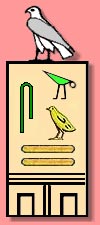 Seshemutaui |
The reign of is considered to have been a peaceful period of slightly over a dozen years. A main task of his was to keep the balance of power between the regional leaders (governors) and the central govern-ment. If loyal to him these provincial leaders could gain a considerable wealth and political influence.
He was interested in carrying out practical matters within Egypt and used diplomacy rather than war-making against his neighbors.
In the Faiyum basin his projects of development turned large areas of marshes into land for cultivation by building dams and digging canals. These vast commitments spent over generations and became a tradition for the kings.
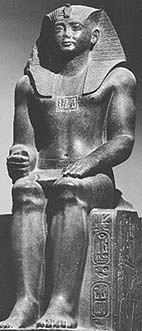 He built his pyramid at Lahun (Illahun) close to the Faiyum and it differed in some ways compared to similar monu-ments. Its innermost core is an adjusted natural limestone rock which was completed with masonry of mud brick. The entrance was not at the traditional north side (see picture below), but hidden under the pavement to the south. At the same side are four shaft tombs belonging to members of the king's family. Three of them were found robbed when excavated in 1914, but the fourth revealed a first class sensation.
He built his pyramid at Lahun (Illahun) close to the Faiyum and it differed in some ways compared to similar monu-ments. Its innermost core is an adjusted natural limestone rock which was completed with masonry of mud brick. The entrance was not at the traditional north side (see picture below), but hidden under the pavement to the south. At the same side are four shaft tombs belonging to members of the king's family. Three of them were found robbed when excavated in 1914, but the fourth revealed a first class sensation.When digging down the vertical shaft a recess came to light at one side. It was one meter high, going in to the bedrock and sealed with mud. When this was removed it was found to be a treasury of unexpected wealth.
It belonged to the king's daughter princess Sit-Hathor-Unut and this was the intact storage of her personal jewelry of bracelets necklaces and finger rings.
In total the archaeologists found: 9.500 beads of different stone material, 110 rings of gold, bracelets and anklets of gold, a golden crown and her toilet razor of copper.
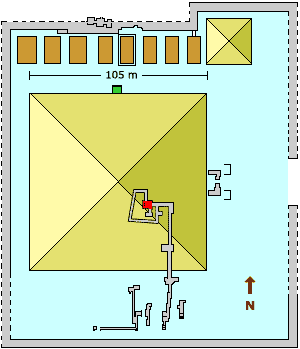 | at Lahun Eight mastabas (brown) and a minor pyramid was situated by the north side and instead of a mortuary temple to the east a small chapel was placed there. Causeway and valley temple have not been found so far (2002) but may have once been there and was later dismantled for reusing, like the pyramid's casing of fine smooth white limestone. |
Another unique find was made when a place by the river bank 1 km east of the pyra- mid was excavated. It turned out to be the location of an ancient so called pyra- mid-town just north of the kings mortuary temple by the Nile shore. These sites were built during the construction and were communities of workmen, craftsmen, admin- istrators etc. who were involved in the ongoing pyramid project.
Its name was Hetepsenwosret (Senwosret is at ease) and was the first of its kind to be found and it was not abandoned when the work was done, but flourished for another almost two centuries hosting a mayor and the priesthood working in the cult of the dead pharaoh. Today it's known as Kahun.
The place had remarkably many objects left in the houses and seems to have been abandoned in a haste. Science was here provided with a lot of information about daily life and housing conditions of different classes.
 Senwosret |
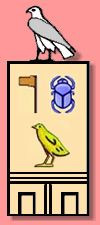 Neterikheperu |
He initiated a series of five campaigns into Nubia and protected the trading routes and mineral resources and to make transport-ation easy he extended an Old Kingdom bypass canal around the first cataract at Aswan. In Semna he erected a stele bragging about how he killed the male population, enslaved their women and children, burnt their crops and poisoned their wells.
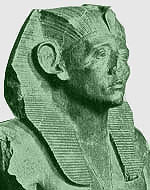 |
He personally lead a campaign into Syria, described on a private stele by a participant as an invasion of plunder.
Senwosret III built a temple to the old Theban war god Mentu north of Karnak and divided the country into three administrative regions. This was to weaken the power of the local governors who were a constant threat to central power during most all the Middle Kingdom. As a side effect of this the middle class grew larger and more politically influential.
He built his pyramid at Dahshur. It was the largest of the 12th dynasty pyramids and had a mud brick core cased by limestone. The entrance was hidden under the courtyard pavement west of the pyramid and the burial chamber does not lie close to the vertical axes (see illu- stration below). Due to its position (like the one in his father's pyramid) there is a slight possibility that the found chamber was for the first queen and the king's is yet to be found. When entered in the 1890s it contained a big empty granite sarco-phagus by its west wall and the only objects found were a few vases and pieces of a bronze dagger with an ivory handle.
The location of the valley temple has never been retrieved and the causeway ap-proaching from the southeast, has not yet been investigated (year 2002).
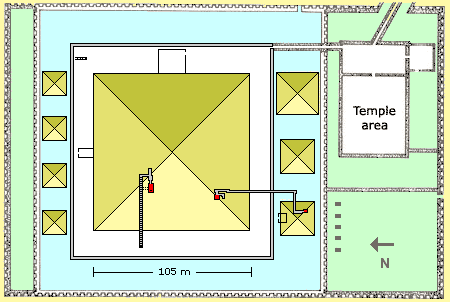 |
The pyramid of Senwosret III at Dahshur. At first a mortuary temple was built by the east side (top) later to be replaced by a new and bigger within the expanded enclosured area to the south. Its plan has not been reconstructed. |
In the lower galleries under the small pyramids to the north 300 pieces of jewelry were found belonging to princess Sit-Hathor, probably the king's sister and possibly also his wife. From the western most of the tombs at the south side a tunnel leads to a burial chamber with a granite sarcophagus under the corner of the king's pyramid (see illustration above). This was found in 1994 and belonged to his mother Weret.
If Senwosret ever was buried in his pyramid is doubtful because he also had a tomb at Abydos with a similar layout as a pyramid complex. From a valley temple a 900 metre long causeway leads to the mortuary temple within an enclosure area. The huge underground tomb was once considered the largest in Egypt. To the south a town was built to support this huge funerary complex.
 Amenemhet |
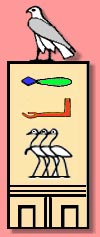 Aabau |
He continued the irrigation program of the Faiyum by building dams and canalling water from the Nile to Egypt's only real lake - Qarun. An estimated area of 620 square km (153.000 acres) of new fertile land was reclaimed in this way.
He erected two colossal 12 metre high statues of himself at today's Biyahmu and statues of Sobek, Hathor and an unusual palm goddess have also come to light.
His long 44-year reign was peaceful and perhaps the peak of the Middle Kingdom with growing wealth and quarrying for minerals and metals all over the country.
Three major construction works of his, besides two pyramids were, in the Fayum: a Temple to Sobek at Shedet and a chapel to Ernutet (the goddess of harvest) at Medinet Madi. In the Nile Valley: an expansion of the temple of Ptah at Memphis.
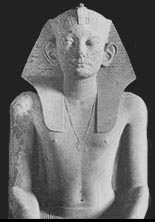 Amenemhet III as a young man |
This might be true because he welcomed many foreign workers, peasants, soldiers and craftsmen to Egypt and once he provided the Nubians with food to appease the effects of a famine. However, by possibly a series of low Nile floods the fragile economic back-bone was damaged and standard fell rapidly by the end of his reign.
Amenemhet III built two pyramids and the first one at Dahshur was a disaster. Today it's sometimes called the "Black Pyramid" and it's surely a dark chapter in the his- tory of pyramid building. For some reason his architects built it on the hard subsoil, not the bedrock and further- more in a low spot that made the groundwater leak in and damage the structure.
Soon after the pyramid was completed (after about fifteen years of work) cracks appeared in the chambers and corridors.
Its inner architecture is very elaborated and differs totally from earlier pyramids of the Middle Kingdom (picture below). Besides the king's burial chamber are others and one them was for the burial of his first queen.
The now destroyed mortuary temple was relatively small and its original layout is hard to establish. A broad causeway flanked by two brick walls led to the valley temple that was a simple construction, with two open courts built in terraces.
At the north side of the causeway just outside the pyramid was found mud brick settlements for priests participating in the cult of the dead pharaoh.
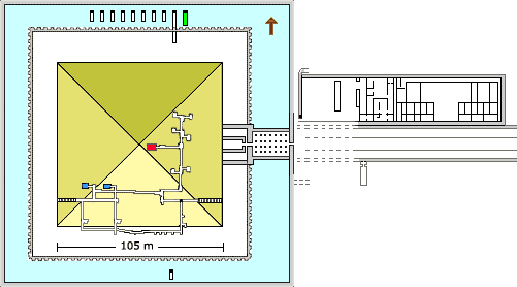 |
The Dahshur pyramid has two entrances. The grave chamber (red) was never used for a burial and held the king's empty pink granite coffin. Two queens were buried within the pyramid (blue) and the other family members had tombs by the north side. One of them (green) was later used by king Hor from the 13th dynasty. |
The king decided to build another pyramid to replace the cracked one, and chose the location Hawara just at the entrance to great Faiyum basin.
It was also built in typical 12th Dynasty fashion with a mud brick core and a casing of white limestone but was technically different to the one at Dahshur.
The whole complex was oriented north-south and surrounded by an enclosure wall covering some 28,000 square meters, the largest from the Middle Kingdom. The valley temple and the causeway, have not been investigated seriously.
The huge mortuary complex (now gone) was once called "the Labyrinth" and well known to tourists during the Greco-Roman era and is said to have been the prototype for its namesake later built for king Minos in Crete. Historian Strabo tells the halls were as many as the provinces in Egypt (42), each honoring its main god. Underground galleries for the local crocodile deity Sobek is also mentioned, but they have never been found.
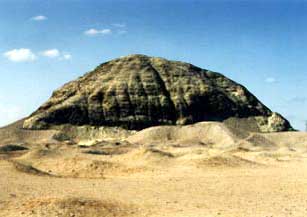 | After the dismantling of the fine white casing stones the whole Hawara pyramid has decayed to a pile of mud brick rubble. Under the sand are the scanty remains of the attraction that brought tourists here already in Roman times - The Labyrinth. This was the mortuary temple. |
In 1889 the burial chamber was entered, but was found only to contain an empty sarcophagus. Within the nearby antechamber was found duck shaped bowls, a wooden coffin and an alabaster offering table inscribed with the name of a princess. Slabs of quartzite were placed to prevent intrusion to the king's mummy and could be put in position by the first known sand lowering device. The construction has great similarities to those of two later pyramids at Mazghuna.
 Amenemhet |
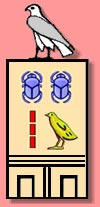 Kheperkheperu |
He was probably a son of his predecessor and had a brief period as pharaoh of about ten years at the most.
He was married to his half sister (below) and poss- ibly built a pyramid at Mazghuna. No name of his has been found at the site and the estimated age of the monument has been made by looking at the architectural and technical details.
We do not know anything about his relatives like the names of his mother, sisters and brothers, or for that matter the true confirm- ation of the identity of his father. There is a possibility that his pre- decessor on the throne was his uncle or even his grandfather.
He is known to have completed several temples and other buildings which were under construction when he entered office. In Nubia rock inscriptions confirm that he was able to hold the territory that was captured by the Egyptian army almost a hundred years earlier, during the reign of king Senwosret III.
Nothing is known of a heir of his (if there was one) and the fact that he was suc-ceeded by his widow indicates that he had no son to put on the throne.
An example from the sparse remains of his is a magnificent piece of jewelry shown in the illustration below.
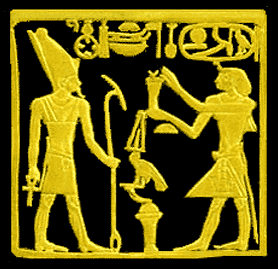 | A small golden plaque of unknown provenance showing Amenemhet IV (to the right in the picture) off-ering to the creator god Atum. It is a so called openwork cutting made from a single sheet of gold. It measures only 3 by 2,8 cm and the details are made with a bril-liant technique showing even the tiny feathers of the owl sitting in the center. Its purpose is not known but it was likely for decoration on a small jar containing ointment or perfumed oil or on the lid to a jewelry box. |
Up to now (year 2002) no depictions in paintings and reliefs etc. has been found showing the looks of Amenemhet IV. Nor is there any statue or statuette that can be attested to him with certainty. His tomb has not been found but it's possible that a pyramid at Mazghuna South (one of a pair) is a monument of his. The location is 100 km north of the Faiyum and 15 km south of Sakkara.
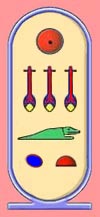 Sobeknefrure |
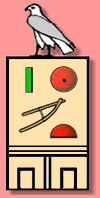 Meritre |
She was most likely a daughter of Amenemhet III and is mentioned in Manetho's text, in the Karnak and Sakkara lists but not noted in the canon from Abydos temple wall.
She was probably the sister or half sister to her husband Amenemhet IV whose title and occu-pation she took over shortly after his death. Often her name app- ears with the addition Shedty, meaning "from Shedet" and this might indicate that she was involved in a religious movement in this town in Faiyum. This cult praised the crocodile god Sobek and it's possible, though not confirmed, that priests of this old local deity were the ones who backed her up as a national leader though their power (and hers) obviously was limited. This would also explain her break of tradition by taking the name aof the crocodile god Sobek as pharaoh for the first time in Egyptian history. After her a row of kings did so due to the upraise of this animal from the swamps of Faiyum where it was more common than along the shores of the Nile itself.
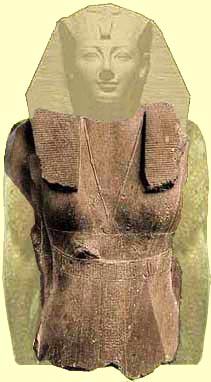 Sobeknefru reconstructed |
The economic importance of Faiyum had been increased since much land for cultivation had been reclaimed from the marshes during the reigns of several kings.
Physical evidence from her reign are scant but inscriptions at the second cataract, a cylinder seal with her names and texts associating her with her father, have survived. She completed her father's mortuary temple where her name appears many times (and that of Amenemhet IV - not at all).
An apparent remain are three fragmentary life-size basalt statues of her found at the site Tell el Dab'a (former Avaris) in the eastern delta. One of them is shown in the picture left with a fictive addition giving an impression of what it once might have looked like. Note that the statue fragment has breasts and does not have a false beard and thus once clearly showed Sobeknefru as a real female pharaoh.
Her tomb has not yet been found, but there is a hardly begun pyramid at Mazghuna North that might be a remnant of hers.
If this is the case she seems to have left the Faiyum area for the more traditional administra- tive and religious centres up north like Memphis and Heliopolis. Where she actually had her residence is not known.
So far (year 2002) no depiction of her has appeared in paintings or 3D form. A possible exception is a small statue from the Metropolitan Museum of Art in New York mentioned in an article edited by C.J. Eyre published in: Orientalia Lovaniensia Analecta, nr. 82 (p 227-236). It is an intact depiction of a female pharaoh with an unusual crown on her head and wearing a Hebsed cloak. The assumption that it is of her is made purely on stylistic grounds and without written (hieroglyphic) backup.
Her reign concluded the 12th dynasty, a prosperous period in Egyptian history.
She was one of very few women (probably one of two in 3000 years) to achieve the rank of pharaoh over Egypt.
The kings of the 12th dynasty tried to bring back the old values from the times of the great pyramid builders. They could not reach the status of gods like the old pha-raohs, but in some fields they were successful, like in arts, where the quality in paintings and sculpture became just as good as during the Old Kingdom, or almost.
With time their pyramids became technically more advanced and showed a great variety in their substructures like positions of the grave chambers, entrances etc.
The written language reached its peak and the "Middle Kingdom language" was to set standard for all future and fine pieces of literature have survived.
1802 - 1649 BC (Ryholt) (c. 140 years)
Dynasty 13 started the Second Intermediate Period (SIP) (some makes the start at dynasty 15) and this era bears many unsolved problems.
The first two kings were sons of the last male monarch of dynasty 12 and Upper Egypt was under control at least through the reign of Sobekhotep IV some 120 lyears later. The capital was Itj-tawy and a traditional belief is that after half the dynasty they kings were forced to move south, but no evidence confirms this. The territory reached north to Bubastis and the borders does not seem to have been changed over the years to the parallel dynasty 14 which controlled the rest of the delta.
In the south dynasty 13 seems to have control as far as the second cataract though- out its existence. Dynasties 13 and 14 seem to have been getting along quite well but a big question is how all entries for dynasty 13 in the Turin Canon should be explained (around 60 kings) making an average reign of 1,5 years for the first couple of dozen rulers. One of many theories is that the ruling class apointed marionette-kings and sacked them when they felt like it. Turin Canon has 57 rows with names and fragment of 50 rulers plus 12 possibly to be put in the rows 15-19 and 49-55. The duration for the dynasty is estimated to c. 150 years (1802 to 1649 BC) making an average rule for all kings of about three years.
This curious fact goes for dynasty 14 as well with around 56 kings over 150 years.
Danish Egyptologist Kim Ryholt has in 1997
published a suggestion for a
chronology.
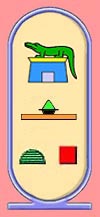 Sobekhotep |
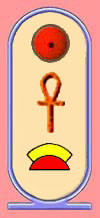 Khaankhre |
The duration of his reign is gone from the damaged list, but a probable figure is estima-ted for at least three a period of years around 1800-1797 BC. His prenomen (seen within the cartouche in picture right) means: "Life of Re is Appearing", made by the hieroglyphs: sun- rise (which means "appear"), ankh (meaning "life") and the sun, standing for the solar god Re. His name occurs on at least a dozen remnants from buildings of stone plus some papyrus inscriptions and an axe blade of unknown provenance.
King Sekhemkare Sonbef was a son of Amenemhet III and by some considered identical to Amenemhet V (see below) and confusion is at hand ordering these insignificant rulers correctly with one thing in common: short periods in high office.
 Amenemhet Sonbef |
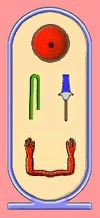 Sekhemkare |
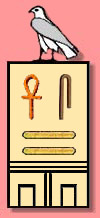 Seankhtawy |
He thus was the son of the king Amenemhet IV of the dynasty before. His nomen was Sonbef, as written by the last three hieroglyphs at right in the cartouche above.
His throne name was "Mighty is the soul of Re", (within a cartouche left), and his Horus-name in the serek right means: "Horus, the one who makes the Two Lands live".
Another find is a stele (below) with his names (center and left) and at right the Nile god Hapi kneeling with offerings on a plate. A cylinders seal with his name (right) was used during his short reign of about 3 years around 1795 BC.
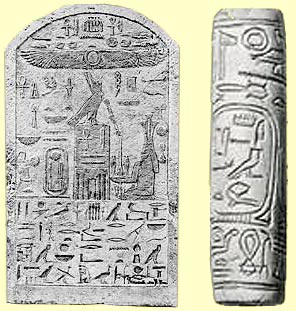 |
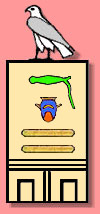 Mesh-eb-tawi |
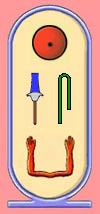 Sekhemkare |
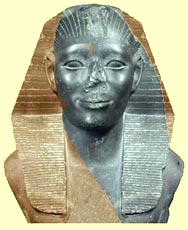 |
 Ameni Kemau |
 Nefer-netjer neb-tauy |
While working at South Dashur an American expedition tried their luck by excavating a low structure of mud brick rubble never worked on before. Soon they discovered a substructure that made them determine that this was a true pyramid, until then unknown to science.
The owner was soon identified as king Ameny Kemau (usualy today written Amenyqemau), a little known ruler from the 13th dynasty, and hard to place in the long line of minor regents from this dusky period. In the Turin Canon appears a pharaoh called Se-hotep-ib-Re with a noted reign of just one year, which may be him. Another suggestion is that he was the son of (and perhaps predecessor to) pharaoh Amenemhet V, but this has not been confirmed, but it might be possible.
His name (in the picture right) clearly confirms his status by the signs at the very bottom (the goose and the sun) which says: "Son of Re", meaning nobody but the king. And in the picture left his personal name is seen within a royal cartouche.
Today (year 2002) the place of his pyramid is hard to determine as man made, and looks more like natural formation in the landscape.
The details of the superstructure have almost totally vanished, but it likely was a construction made of a mud brick core cased by limestone. The complex probably didn't have an enclosure wall and any subsidiary tombs has not been found.
The remains below surface have been preserved in a better way and are well docu- mented from a second investigation made in the late 1960s.
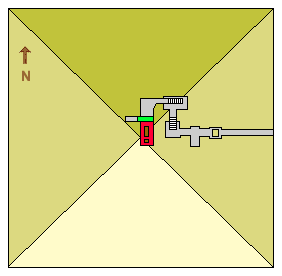 | A huge block of stone (green) was a stopper at the threshold of the buri- al chamber (red). Nothing was found of any mortuary temple, causeway or valley temple. It's doubtful if there ever were any built and if the pyramid itself was ever finished. The base side was originally about 52 meters and the height about 35. |
Despite these precautions taken by the architect, the monument was entered by grave robbers who ransacked it of its valuable things leaving only fragments of the canopy chest behind. Luckily for the afterworld it was on these pieces of stone that the king's name was found some 3,700 years later (the serek-pictures above left).
The pyramid of Amenyqemau was one of the last monumental pyramid for a king's final resting place to be built in Egypt, and as such it is a valuable object for studying the long development of this famous type of tomb.
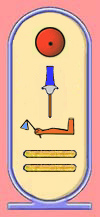 Sekhemre suadj-taui |
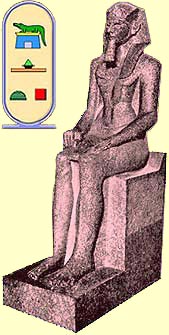 |
At Deir el Bahri (western Thebes) and Medamud eight km northeast of Luxor, he made additions to the old temples of Mentuhotep I, which were built almost two centuries earlier.
A statue (picture right) made of red granite, shows him sitting on his throne and this piece is today (year 2002) at exhibition in the British Museum. His throne name (within the cartouche in picture upper left) means: "The Powerful Re Rules and Protects the Two Countries".
His name has also been found on a block of stone from a chapel and an altar from Abydos. At Karnak a fundament from a statue of his is known and in the Petrie Museum in London his name is present on a fragment from a column. Where and in what sort of tomb (pyramids were on their way out) he was buried is yet (year 2008) to be found.
 King Hor |
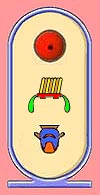 Au-bri-Re |
At Hawara by the north side of the pyramid of Amnemhet III a small tomb was found to be his last resting place. Among other things it also contained a wooden statue of him.
This life size (1.7 m) sculpture is today a masterpiece of its kind in the Egyptian Museum in Cairo (picture left).
The statue is depicting the king's Ka (an invi-sible follower) which walked beside every human being in life as well as after death.
It was thought to take possession of the mummified body and was symbolized and shown in hieroglyphic writing as two up-reached arms, and now placed upon his head.
The eyes are made of white and blue glass, a rare color of the eyes of the Egyptians. The tomb was untouched by robbers and also contained his mummy within a wooden coffin plus some items of the funerary equipment including a wooden chest.
Some indications in the tomb may point to the fact that a later king - Khendjer, took part in his funeral, but opinions among Egyptologists are divided in this matter. Pharaoh Hor had a brief reign (7 months to 2-3 years) around 1776 BC.
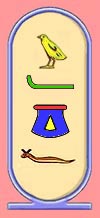 Wegaf |
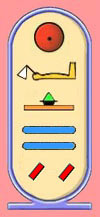 Khwitawyre |
He is likely to have ruled from the capital Itj-tawy as the first in a row of about ten kings who had rather stable rules. His throne name (within cartouche right) means: "Re Protects the Two Lands", and sometimes the signs at row three and at the bottom are left out. At left his per-sonal name Wegaf is seen written with phonetic hieroglyphs.
His remains are rather few (7) and just a single scarab-seal is documented from his time as the senior commander of Egypt's military forces before he became pharaoh.
 |
In the early 1980s a former anonymous statuette on display in the Egyptian Museum was reattributed and determined as being his.
A find of an Ostracon (single piece with temporary drawing/writing) from the island of Elephantine in Aswan shows his name together with the nomen of king Senwosret, (which one is unclear). In total half a dozen physical remnants of his are known including a statue (a the Egyptian Museum in Cairo) plus a stele and a statuette (stele seen in drawing left), now both in the museum in Khartum, Sudan.
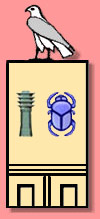 |
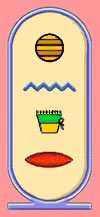 Khendjer |
His name was known before, from a stele, but here another throne name was used. For some time the question was if there were two kings called Khendjer, but soon scientists agreed on that it was one and the same pharaoh from the stele found at Sakkara and the one possibly mentioned in the Canon of Turin. His Horus name "Djed Kheperu" (firm is Kheper) is seen within a serek right, and his reign would have lasted circa
The whole pyramid area of his had once been enclosed by two walls, the outer made of mud brick. The inner one was of limestone and had niches and panels and remains indicated it apparently had replaced an unusual wavy wall, just like the one surrounding the pyramid at Mazghuna South from king Amenemhet IV around half a century earlier (see above).
The mortuary temple was located on the east side between the walls and the only remains were bits of reliefs and parts of the pavement from the court yard. Luckily fragments from columns were inscribed with his name, and thereby identifying the constructions as his. Investigations of the fragmentary pyramid lead to the conclu-sion that it once had a base side of 53 meters and a height of about 37. After having been quarried away over the years it is considerably reduced in height today (2002). Compared to what it once had looked like in its prime.
Many fragments of the black granite pyramidon (capstone) was found in a rather well preserved condition at the east side and is now reconstructed (put together). It's inscribed with the king's throne name - Userkare.
A chapel to the north was built against the pyramid's facade. It stood on a platform and was reached by two stairways.
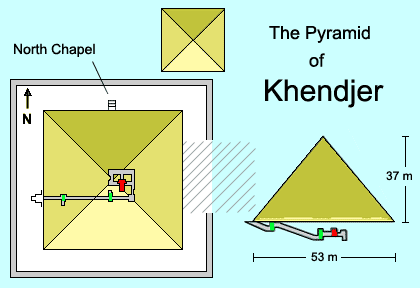 |
The pyramid complex of Khendjer once had two enclosure walls and the mortuary temple was placed in between (striped area). Huge stoppers (green) blocked the way to the grave chamber (red). |
Fragments of reliefs that once adorned the walls have been found, depicting scenes of offerings and other well known motifs. The entrance was at the west side (picture above) with a stairway leading down to a portcullis that never was engaged and 39 steps further down was a room with stopper number two. Prior to the superstructure the grave chamber was built in a shaft cut out in the bedrock. Huge blocks were sealing it from the top and lowered to their final position by a devise making them fall into place when the sand they temporary lay on was drained out from below through small channels. This technically advanced method is also known from the pyramid remains at Mazghuna South attributed to Amenemhet IV (see above).
Just outside the inner wall at the north west corner are the underground remains of a small (c. 20 m square) subsidiary pyramid possibly built for his first queen. Within the area are also shaft tombs most likely belonging to other family members. All of it was found in an unfinished state when it was discovered in the late 1920s, and poss-ibly never used for burials. An inscription on the sarcophagus in the grave chamber below the queen's pyramid, gives an indication of the duration of the king's short reign - four years. Apart from his tomb all remains left of pharaoh Khendjer are three statuettes of him, three cylinder seals with his name, a few scarab seals and a stele.
If Khendjer was coming from outside Egypt (and his Semitic name indicates this) he may have been the first recognised Pharaoh of non-Egyptian origin.
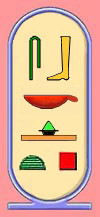 Sobekhotep I |
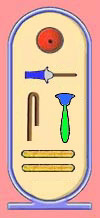 Sekhemre Sewadjtawy |
The whole meaning is: "Powerful is Re, Who Makes Two Lands Flourish". He was not of royal stock and his parents (noted in a temple inscription) were commoners. Despite his quite short reign a lot artifacts from his reign are know and among them over 30 scarab seals.
 Scarab seal of Sobekhotep |
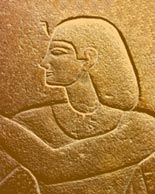 Sebekhotep III in low relief. |
Remnents of monuments of his are found in el Kab (a small chapel) and Lisht. A few cylinder seals are known and many scarab seals (see picture right). An altar on Sehel Island at Aswan bears his name, and so does an axe handle and a small gold ball, possibly from a necklace. He can be seen as a stone sphinx (Egyptian Museum) and has a statue dedicated to the creator god Khnum exhibited in the Medelhavsmuséet in Stockholm Sweden.
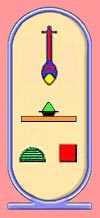 Neferhotep |
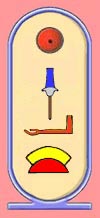 Khasekhemre |
The hieroglyph for satisfaction is a loaf of bread on a reed mat (cartouche left) indicating the seriousness the Egyptians had in their relation to food.
He is listed as number 27 in the Turin Canon and noted to have been in office almost a dozen years around 1742-1731 BC.
His throne name (within the cartouche in the picture right) means: "Mighty is the Appear- ance of Re". Neferhotep I came from a military family of none royal stock (at least on his father's side) and possibly from Thebes. His queen's name was Senebsen and they likely resided in the main capital from witch the king ruled the country - Itjtawy near Lisht by the Fayum in middle Egypt.
 Scarab seal and statue of Neferhotep I |
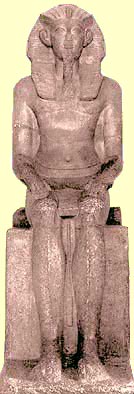 |
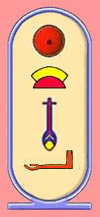 Khaineferre |
He was one of the most powerful kings of the dynasty and is known to have secured the southern frontier by sending troops down into Nubia.
His reign (and his brother's before him) can be considered as the peak of the 13th dynasty, which was a rather shaky and politically troublesome period. Luckily there is a fine unbroken statue left of him showing his looks (picture left). He is sitting on his throne and his face is made in typical Middle Kingdom style with big ears pointing out. This unique piece is today to be seen at the Louvre Museum in Paris.
He was a younger brother to Neferhotep I whom he succeed- ed on the throne. Their father was a priest and their mother was possibly of royal stock and if so possibly a (grand?) grandchild of Amenemhet III from dynasty 12. His queen was called Tjan and has left an inscription (probably made after her husbands death) where she tells how he went to Heliopolis and studied the old scripts and took a statue of the god Osiris in a procession. It ended in the old capital down at Abydos in the so called "Osiris' Tomb", where the priests performed the well known story of his deeds. The duration of his reign is not noted in the Turin Canon, but is estimated to have been a dozen years around 1732-1720 BC. During his reign the Hyksos made their first appearance, and took control of the town of Avaris in the Delta around 1720 BC, and started their conquest of the week and split up Egypt.
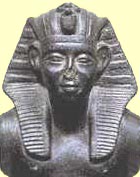 |
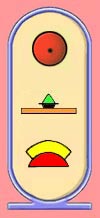 Khahotepre |
His time in office was not very long and his reign as ruler number 25 of this dyna- sty is estimated to a period of about five years (Turin Canon says four) around the years 1720-1715 BC.
Little to nothing is known about his deeds and the only remnant of substance left from his time on the throne besides some (10) scarab seals, (including impressions and a cylinder ditto), is a statuette found in Kerma in Nubia, now in the Museum in Berlin (seen in picture left). This find indicates that Egypt though week, had influence possibly next to control over this remote region known for its own identity and struggle for independence throughout the long Egyptian history.
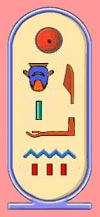 Iaib (Ibiaw) |
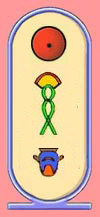 Wahibre |
With his successor Aya he is ending a line of kings with well attested rather long reigns and the followers all are estimated for very short periods on the throne.
From his almost eleven years in office (10 years, 8 months and 29 days in Turin Canon) around the years 1712-1701 BC. some remains are left that confirms his existence and they are: 1) Nine scarab-seals of
 Seal of Wahibre |
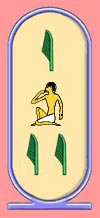 Aya (Ay) |
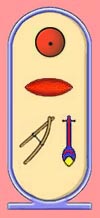 Merneferre |
The Turin Canon has Aya in position 33 and he is the king from the dynasty with the longest reign noted - almost 24 years. One theory says that the Hyksos rulers expanded southwards and had captured Memphis by then, making Aya flee to the south from his capital Itj-twy, (which hasn't been found for sure by modern archaeology).
Ryholt claims 1997 that nothing of this scenario can be proven by substantial evidence and on the contrary the border between the two neigh- boring dynasties 13 and 14 seems to have been quite stable throughout the times.
His reign was for 23 and 3/4 of a year (according to the Royal Canon of Turin) and it likely occurred during the years
 Seal of king Aya |
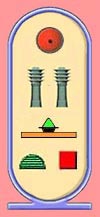 Djedhotepre |
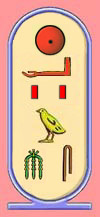 Dedumes |
He is known from Manetho's historical work as the king who had to give up his country to the attacking Hyksos people. In this chronicle he is given his Greek name Totemaios.
For some unknown reason he is not present in the Turin Canon and i only attested for by re- mains from Upper Egypt, but this doesn't mean that the invasion scenario told about him (start-ing in Lower Egypt) is not a fact.
Another king with the same name and given the number II has initiated a discussion about his true position in the 13th dynasty.
The Egyptologist Kim Ryholt has (1997) in his work about this period put him in the 16th dynasty in a place not to be determined in the sequence of names.
This lack of agreement among the experts is due to the fact that at least three (by some scholars up to five) dynasties were operating at the same time in the split up Egypt. (See textlink "Second Intermediate Period" at dynasty 13 above).
 One possibility might be that Dedumose had to capitulate to the foreign enemies and his followers were marionette rulers, but this is just a suggestion of many from this politically very complicated period.
One possibility might be that Dedumose had to capitulate to the foreign enemies and his followers were marionette rulers, but this is just a suggestion of many from this politically very complicated period.Remnants of his are scant and apart from his names and titles found in single inscriptions, a remarkable stele has been found at Edfu made by an unnamed official giving himself the title "the king's son", and tells Dedumose's all titles and names and among them his Horus-name within a serek (left). It was Wadj-chau, meaning "Fresh at feature" un-derlining his physical fitness necessary to do his job properly in the eyes of the people. This stele is now in the Egyptian Museum in Cairo.
1750 - c. 1670 BC. (c. 85 years)
Egypt was now split up and dynasty 14 (parallel at least to the mid 13th) was ruling from Xois in the north eastern delta and was (at least indicated by some names) of Asiatic (Hyksos) origin. The Canon of Turin note 32 names in a list which has space (rows) for about 60. Several lists and theories are at hand, like suggestions that they were province leaders, vassals, made up, or ancestors(!) to the living pharaohs.
Schloars of today (year 2002) distribute some names among all dynasties 13-15.
Manetho (through Africanus) writes that 76 kings ruled for 184 years.
The duration of their reigns indicate about two years each on the throne in average, and these unlikely figures still awaits an explanation.
Danish Egyptologist Kim Ryholt has in 1997
published a suggestion for a
chronology.
Just a few kings from dynasty 14 are known from seals in shapes of scarabs (see picture), and besides Nehesy's below the only remain of substance is a stone stele.
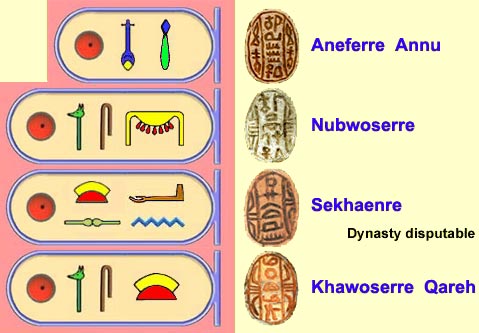
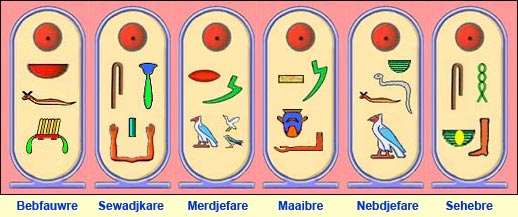
 Nehesy |
 Aasehre |
Nehesy has left a row of remnants from his reign: 1) An obelisk at the temple of Seth at Raahu (in the north east delta). 2) Two stelae at Tell Habwe. 3) A column at Tanis holding his mother's name: Peret. 4) At least 23 seals mostly being scarab amulets with his name carved into the flat bottom. In the Turin Canon he is listed as the first pharaoh of dynasty fourteen, but a great gap in the papyrus indicates a row of about five kings (see list above) who probably ruled before him. Estimations have been made indicating that these had rather long periods in office compared to most later kings, which makes the time when Nehesy was in charge to have possibly occurred around the year 1705 BC.
The damage Turin papyrus cannot give him more than half a year in office, at most.
His name Nehesy means "Nubian" in the Egyptian language and may indicate his origin and background, since soldiers from the south by tradition were a great part of the Egyptian military forces. Despite this he seems to have belonged to the ex- treme opposit part of Egypt - the Delta in the far north.

ليست هناك تعليقات:
إرسال تعليق